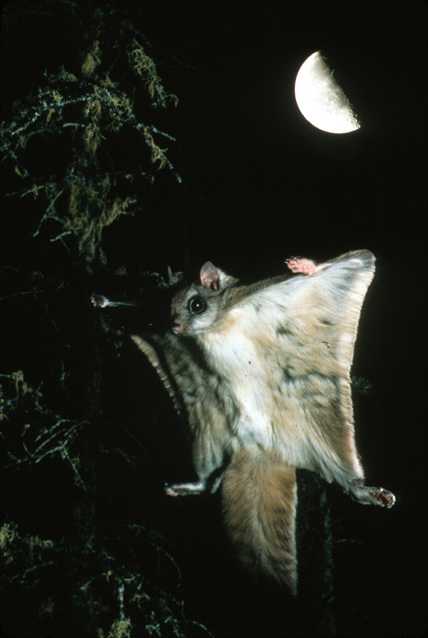


Southern Flying Squirrels are found in many parts of Southern and Eastern
United States.
They nest in high trees and nooks
and crannies of branches. A southern flying squirrel is about 3-4 inches
long from head toe and weighs about 3 ounces. It has a rusty brown color
with creamy white under parts. Their fur is soft and thick. Their eyes
are large and dark brown . Females
are a little bit larger than males.
They have a total of twenty teeth.
They
have about 3 to 4 babies. But they've recorded more. The babies are
born with their eyes
closed and hairless. They remember
how to fly at the time they are born . Four weeks after they are born they
can open their eyes . Flying squirrels will breed up to twice a year.
Flying squirrels
can glide up to 150 feet. They can only glide down. Flying squirrel can
live up to 12 years. They store food in their nest . The females
guard their nest from other squirrels.
A squirrel eats nuts, fruits, buds,
insects, small birds, and small eggs.
Caring for a flying squirrel:
Like other nocturnal animals, flying
squirrels do not aquire enough Vitamin D. Vitamin D helps digest nutrients
like calcium. A natural source of Vitamin D comes from exposure to the
sun. Since the flying squirrel is nocturnal sun exposer is limited. To
keep your squirrel healthy, you should supply your squirrel with a calcium
block and Aviton© liquid vitamins. Aviton© is a source of Vitamin
D normally used for birds. But if you put the recommended dosage (drops/oz
of water) your squirrel can be healthy. Not all squirrels like the calcium
blocks so you might need to sprinkle calcium on top of their daily fruit
supply.
Calcium deficiency can lead to paralisis of the hind legs and/or death. Some signs of a calcium defiencey are hostility, long claws that will get caught on clothing, and hopping movement like a rabbit instead of normal crawling. Be sure to supply your squirrel with fresh water with Aviton© and a calcium block. Make sure the calcium block is at the top of the cage, in case the squirrel accidentally unrinates in their food, they will not eat it.
Dehydration can also be a hazardous.
Make sure that you give your squirrel fresh water/Avitron© everyday
and plenty of fruits. Their food intake should be 60% fruit and 40% nuts/seeds.
You can also feed your squirrel small insects like meal worms (a great
source of iron). You can watch for
dehydration in the color of the
urine. If your squirrels urine begins to turns very orange remove all nut/seeds
and feed your squirrel lots of fruit. It has been known for a squirrel
to die of dehydration next to a bowl of fresh water. Salt spools can help
your squirrel retain water and stop dehydration. You do not need to sprinkle
the salt on the fruit everyday like the calcium, but if your squirrel is
suffering from dehydration, sprinkle some salt on top of the fruit. The
salt spool should also hang
from the top of the cage like the
calcium block.
|
|
|